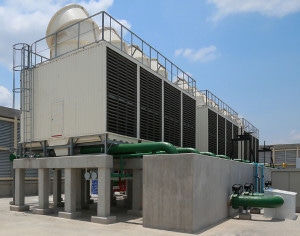Water Wasters: Poorly-Maintained Cooling Towers Foul Up Savings
 Many commercial buildings depend on the efficient performance of water cooling towers. According to the Los Angeles Times, however, older towers are effectively “swamp coolers” in disguise, piping down water so corrosive it can’t be used for a second cycle. The result? Big money to cool even small spaces, along with a real risk of diseases like Legionnaires.
Many commercial buildings depend on the efficient performance of water cooling towers. According to the Los Angeles Times, however, older towers are effectively “swamp coolers” in disguise, piping down water so corrosive it can’t be used for a second cycle. The result? Big money to cool even small spaces, along with a real risk of diseases like Legionnaires.
Conservation Considerations
As noted by the LA. Times piece, water regulators have been working to improve the efficiency of sprinkler systems, faucets, and toilets in an effort to conserve water—especially critical in states like drought-ridden California. But cooling towers have gone largely unnoticed since even older models are still “doing their job” by keeping buildings and occupants cool. Most of these towers, however, are at least 20 years old, with some reaching back to the late 1950s. And while its worth applauding their continued functionality, recent investigations have uncovered that these towers are nowhere near peak efficiency.
Ideally, a tower cooling system should be able to pull heated water from the basement, cool it on the roof, and then send the same water back down for another three to four cycles of heating, evaporation, and cooling. Eventually, “blowdown” in the system causes cycled water to become extremely corrosive at which point the cooler must be refreshed with new water from the municipal supply.
Older coolers which haven’t been properly maintained, however, can only get through a single cycle before blowdown becomes a problem—as a result, many of these towers consume as much water to cool buildings as these same building use to service kitchens, bathrooms, and even drinking fountains.
Illness Implications
Of course, blowdown also comes with another problem: Disease. Bacteria such as legionella love moist, hot, mineral-rich environments such as the inside of poorly-maintained cooling towers. Even with continual water replacement, towers that are too old or haven’t been serviced properly offer the ideal growing location for legionella bacteria, which can quickly spread to the building’s potable water supply. This ramps up the cost of running older towers from monetary loss to potential loss of human life—something no business owner or facility manager wants on their conscience.
In some cases, the best course of action is upgrading; David Hodgins of the Los Angeles Better Building Campaign says that only 10 to 20 percent of operating systems meet the five-to-six cycle threshold. But with prices running into the $100,000-plus range, it’s often cost-prohibitive for companies to fully replace older units with more efficient alternatives.
Your best bet? Start with professional assessment to determine if remediation rather than replacement is a possibility. If so, seek out maintenance contractors with a history of superior service and commitment to leveraging the right tools—such as the TFC-200 Cooling Tower Fill Cleaner—and HVAC best practices when it comes to cleaning your tower cooler.
Old coolers are fouling up water savings and putting the public at risk. The reality, however, is that not every company can afford a total replacement—consistent maintenance, however, goes a long way to improving cycle efficacy and reducing the chance of water-borne illness until new towers make the budget.
Next Steps:
- Subscribe to our blog to stay informed about the latest HVAC news and insight.
- Stay up to date on facility maintenance tools such as chiller tube cleaners, boiler tube cleaners, hose/pipe cleaners, descaler systems, industrial vacuums, commercial pressure washers, and drain cleaners.

